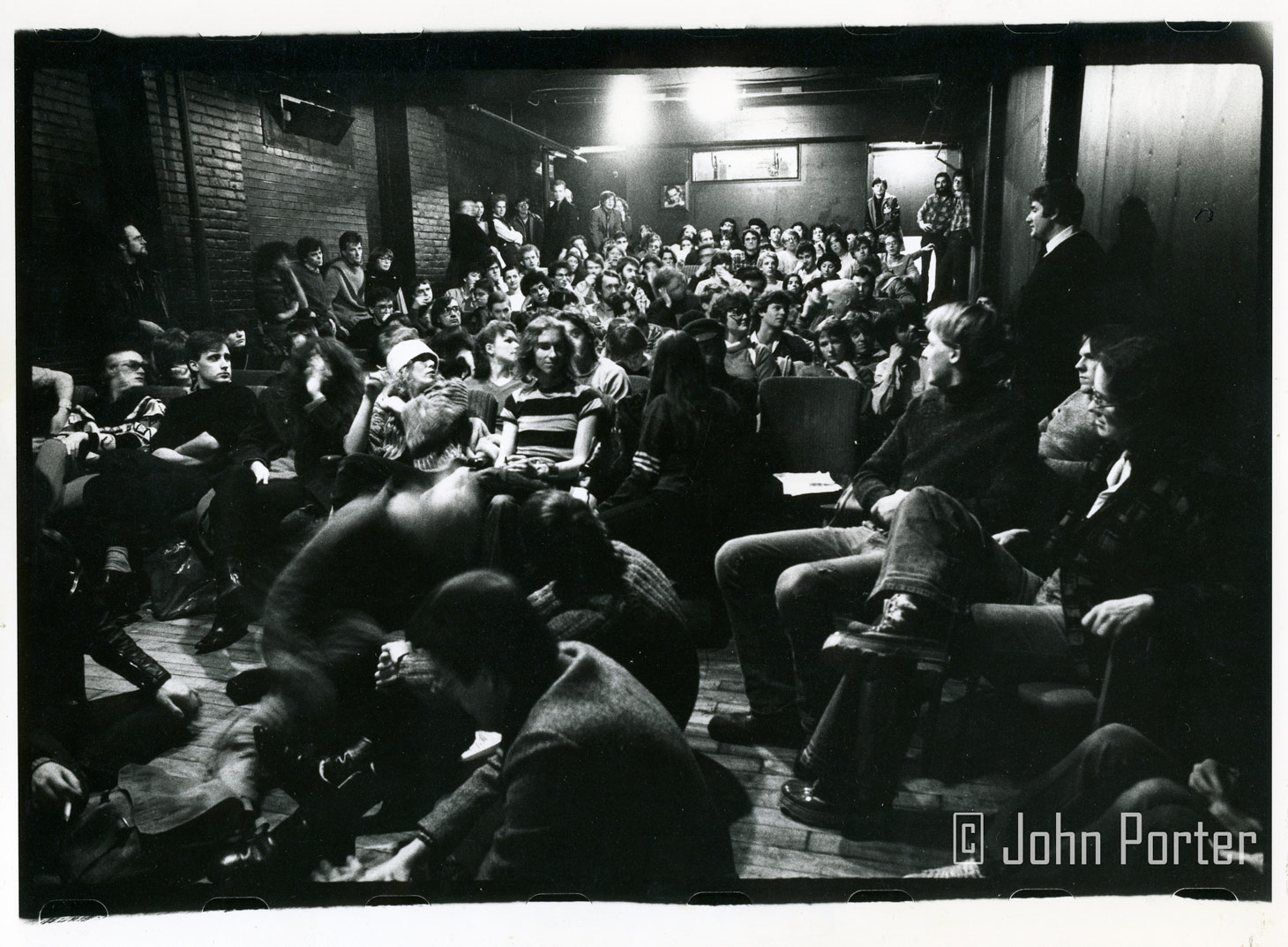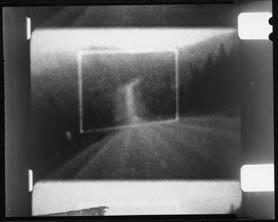
Andy Warhol Superstar Ondine (standing far right) presents “Chelsea Girls” at The Funnel, 507 King St. E., Toronto – February 16, 1980, photo by John Porter
In a booklet on the Funnel, published in the spring of 1981, critic and filmmaker Blaine Allen of Kingston wrote of “Funnel” films: “the filmmakers’ output as members of the Funnel is limited compared to their output prior to its incorporation… this leads to problems of the critical terms within which such group work is to be read. In particular, the issues are influence on the one hand, and common ideals or preoccupations on the other. Both are pertinent, although the former seems a question for the future and the latter seems a route for provisional analysis.”
Although these words were written only a matter of months ago, I believe that the works in this group show to celebrate the opening of the Funnel’s fourth season at its present location, contain some answers to Blaine Allen’s queries.
In most cases, the films in this program have been completed very recently. Some have been interim, short projects while the filmmaker is engaged in producing a major work at the same time. The fact that there are such large projects under construction is in great part due to the establishment of special funding specifically for experimental film through the Ontario Arts Council. And the existence of this kind of funding stems from the presence of an experimental film community (ie. the Funnel) and the influence this community has been able to exert to change the working conditions of film artists in Ontario. So in a roundabout way, the existence of the Funnel (its filmmakers/members) is responsible for the nature of the works in this show (shorter interim pieces related to larger, continuing bodies of work).
It is interesting to note the number of other ways in which this community fact influences the kind of work done. For example, the volunteer system by which these artists ensure that the Funnel continues to operate means that they probably attend more experimental film screenings than anyone else in Canada. Their “influences” then, include not only each other, but many of the films show at the Funnel by filmmakers from around the world. Among the filmmakers whose works appear to have influenced this particular group of films are: Ernie Gehr; Take Iimura, Larry Gottheim, Vincent Grenier, Robert Rayher, and of course, Michael Snow. (And as a sneak preview, I’d like to predict the influence of David Wharry and Erica Beckman in some of those longer films now in production!)
Some of the films on tonight’s programme represent a direct response to the physical setting of the Funnel. The filmmakers who built the theatre, purchased and installed the filmmaking and projection equipment have, in some cases, made pieces that are “for” this particular projection situation, although they can be adapted to show elsewhere.
But what of the “common ideals or preoccupations?” The films seem to display certain visual consistencies to do with an awareness of the film frame as a flat light field. And all of them have what appears to be a kind of skepticism about film’s ability to mediate any “objective” view of the physical world. A distancing results which allows the viewer to see the “subject” and the “material” simultaneously. But apart from these shared premises, the pieces on tonight’s programme spring from as many different attitudes and aesthetics as there are filmmakers. From personal document to visual poem to social satire, each film is part of an individual artist’s personal approach to dealing with the medium of film and the world around him/her. In many cases references to previous works by the filmmaker can be found, as well as the continuation of the development of concerns and issues raised in other parts of his or her body of work.
In his piece on Funnel films Blaine Allen has stated: “A definitive analysis of the Funnel’s films seems both difficult and unwise. There are several reasons for such a prohibition. One is certainly the youth of the Funnel as a filmmaking body and as an organization.” I would venture at this point to suggest that the signs of maturity are to be found in two places. One is in the development of individual filmmakers of strong cohesive and progressive bodies of work. For many Funnel filmmakers this is gradually becoming a reality, and for those just beginning, there is certainly the support, both material and moral to make it so if the filmmaker has the talent and mettle to see it through. The other sign of maturity is to be found in the group’s ability to function as an efficient, resourceful, co-operative and imaginative organization. And on this score too, I think they come through with flying colours.
Still Life by Michaelle McLean 1981 Super 8 2.5 minutes
The movement in this moving picture is limited to changes caused by the wind. As light moves over the still life arrangement in this short film a sense of surface is revealed. McLean’s concerns with texture and light as seen in the earlier work, Morning Bed X are continued here.
Royal Wedding by John Porter 1981 Super 8 15 minutes
John Porter has taken his Condensed Rituals series a step farther with this film. The ritual of the wedding becomes the ritual of watching it on T.V. – being plugged in to the vast consumer network which makes history and plates commodities of equal value.
Song by Robin Lee 1981 Super 8 10 minutes
Robin Lee has constructed a lyrical piece which explores formal and visual aspects of film such as the rectangle, the film grain, and film colour. The natural blue colour of un-filtered daylight on Super 8 film has become the subject of investigation and improvisation.
Audrey Way Up North by Jim and Dave Anderson 1981 Super 8 9.5 minutes
Filmmakers and brothers, Jim and Dave Anderson have pooled their filmmaking talents to produce this document of a visit to Red Lake to see their sister. The film is meant to be projected at an extremely slow speed and blown up very large on the screen so that the film grain and blotches and scratches on the film surface become as much a part of the story as the vignettes of northern life. The film takes on the quality of memory itself through these distortions. Reminiscent of Dave’s Washago and Jim’s Moving Bicycle Picture.
Lady’s Face by Stephen Niblock 1981 Super 8 and 16mm 10 minutes
This double-screen projection piece by Stephen Niblock is a hand-made film in the true sense of the word. Chevrons of different coloured film sections were actually painstakingly inlaid by hand. The surface has been spray-painted. The result in projection is a multitude of layers reinforced by the similarity of the manipulations on both screens.
